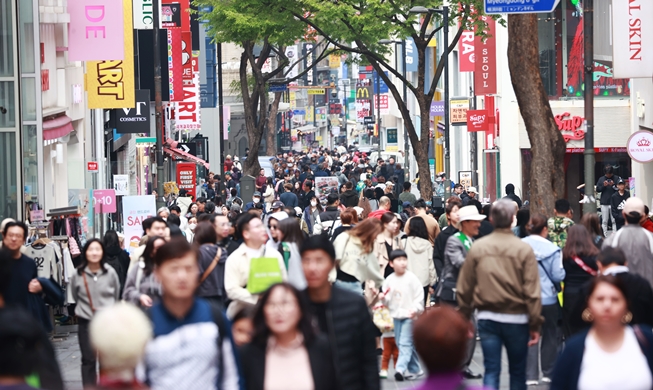-
 Korea.net's 24-hour YouTube channel
Korea.net's 24-hour YouTube channel- NEWS FOCUS
- ABOUT KOREA
- EVENTS
- RESOURCES
- GOVERNMENT
- ABOUT US
In the case of the Korean people, the assumption was that Mongolians and other tribes from the north moved southward onto the Korean Peninsula through Siberia and Manchuria. That was the common assumption until one art scholar began investigating Korean faces. It was face specialist Cho Yong-jin of the Korea Face Institute.
He has a one-of-a-kind background as a painter specialized in anatomy and anatomical illustrations. After receiving his bachelor's and master’s from Hongik University in Oriental painting, Cho taught art at universities, including the Seoul National University of Education. After quitting his career as a professor, he focused on conducting research into human faces. Conducting many autopsies on both humans and other animals for almost 50 years, he has been examining the characteristics of many living things.
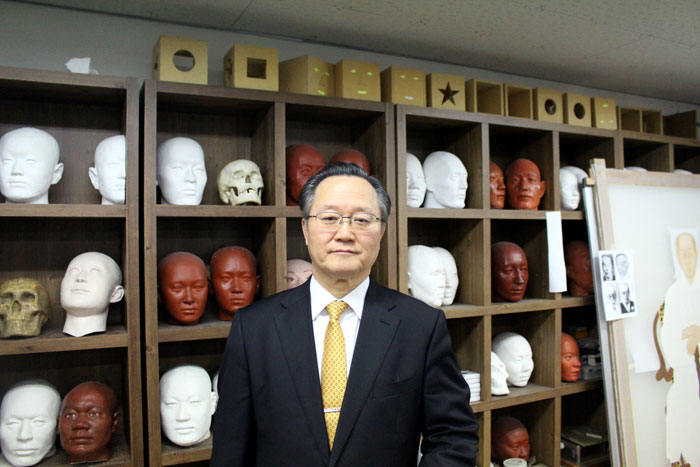
Cho Yong-jin of the Korea Face Institute spends his life researching the face of the Korean people. With a background as a painter who majored in anatomy and anatomical drawings, his experience covers many areas, such as history, anthropology and medicine.
According to Cho, Koreans today are descendants form both northern and southern ancestors. In his analysis of facial characteristics, about 20 percent of Koreans show features of the southern ancestors, and 80 percent of them have characteristics of the northern ancestors. Cho says that people with southern ancestors have features like darker eyebrows, double eyelids, a short and wide nose, thick lips and thick hair, a lot of hair on men's faces, a square-shaped jaw and dark skin. Cho states that those who have northern origins have lighter eyebrows, longer and more prominent noses, no double eyelids, small eyes and thin lips. Cho says, “Southern people spread to North Asia before the Ice Age while northerners slowly entered North Asia from Africa. On the way, about 25,000 years ago, they were locked by glaciers around Lake Baikal for many years and fled to North Asia when the Ice Age ended. The first humans on the Korean Peninsula were southern people.”
These remarks help us to approach the original forms of humanity by gathering the scattered pieces of a puzzle. As human faces from the past are reflections of humanity's movement across the globe, it helps us to predict what our faces might look like in the future. Korea.net recently sat down with Cho, who has devoted his whole life to focusing on research into the human face, to talk with him about his journey through facial studies.
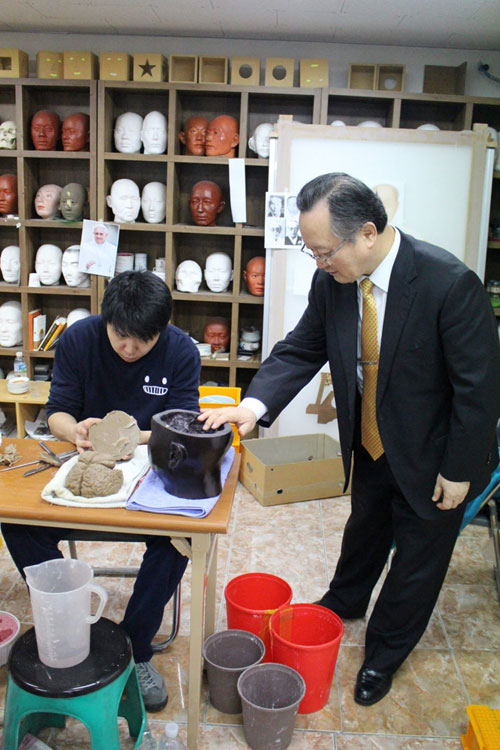
Cho (right) explains to a student the structure of the human brain.
- Please tell us about some reasons why someone might quit a stable job as a professor at a state university just to focus on such research.
I was getting old and it wasn't easy to continue working as a professor. It was the work-life balance. I lost many hours conducting research. It was my choice to grab the chance, because there are many things into which we can conduct research, but life and physical strength are limited.
- What motivated you to focus on studying the human face?
When I was in the third grade, I met a female teacher. Her father came to Seocheon-eup, Chungcheongnam-do (South Chungcheong Province), as the head of the village office. She followed her father, became an elementary school teacher and later became my homeroom teacher. I had no brothers or sisters. She had a huge influence on me. She brought me to her home once during vacation and told me about the books she read, including "The Last Leaf" by O. Henry. She said to me, “I hope you can become an artist like Leonardo da Vinci, as you are talented in the fine arts.”
Luckily, one of the six series of encyclopedias made by Hagwonsa was published at that time. My uncle, who was a student at a teacher's college, had a complete set. As I didn't have many books at home, I almost memorized everything written in the encyclopedia.
The teacher advised me to study anatomy in order to become a painter. I was deeply impressed by her and have been thinking of becoming a Da Vinci ever since, so that I could become him after 50 or even 500 years. Having followed in his footsteps, I became a human fossil 500 years ago. [Laughing] I studied anatomy since middle school and high school.
- It is almost impossible to explain your journey without explaining your passion.
During my university years at Hongik University, Professor Kim Won, who was an artist in Western-style painting, had a skeleton in his office. He selected me to be his student. Kim was from Pyongyang and studied art in Japan where he learned from Nishida Masaaki, who created very artistic anatomical drawings. Japan had already accepted artistic paintings of the anatomy some 150 years ago. I drew paintings of an anatomical chart when I was a freshman at university. On November 16, 1968, I swore that, “Eyes focused on victory never look to the side,” and finished my drawings on January 6, 1969. The collection of my drawings was published as “Drawings of the Anatomical Chart of Humans” when I became a sophomore. Many university students in arts departments across the country bought the book because it was very helpful.
In 1972, I saw an advertisement in the Hankook Ilbo that the School of Medicine at the Catholic University of Korea was looking for an assistant in the anatomy department. Thanks to that opportunity, I learned about anatomy in the proper manner. In October 1972, I participated in a dissection during an anatomy class at that university. With the resolution to, “Search for the truth by devoting my body” (부신해진, 剖身解眞), I made up my mind to search for the truth by inspecting the structure of the human body, such a small universe.
It was a Saturday at 10 a.m. on April 23 that I began my first dissection. It was my first introduction to true anatomy. I studied anatomy at university for seven years. I focused deeply on the human body because I enjoyed it, regardless of my grades. Studying is learning something which others have done, whereas researching is finding out the unknown, which others do not yet know. For me, I am more of a researcher than a studier.
- You must have had a very rare experience as an art student.
Even when I ate fried chicken, I didn't eat it as other people eat it. Instead, I looked carefully at the bones to see which muscles were attached where. I first focused on observing animals, and then began to do so with plants. I thought that a systematic explanation would be better at measuring the shape as accurately as possible. It is possible to measure existing phenomena. To measure the human face, I made a special shooting device that uses contour lines. The way to describe one's facial appearance had not been developed at that time. I thought about how to explain and deliver the facial shape of a certain person using words, and how to make other people understand, even though they couldn't directly see the person’s face.
- In the past, there were theories about Altaic languages and about the origins of the Korean people. Your face research made it much more concrete. Please tell us about that.
Yes, it did. The southern ancestors came to Korea for the first time some 12,000 years ago. At that time, the sea levels around Sundaland, today's Indonesia and the neighboring region, began to rise due to global warming, creating the Greater Sunda Islands. This, in turn, raised population density. In the pursuit of better lives, families who used to reside in Sundaland came to Korea along the coastline. The Stanovoy Mountains (흥안령 산맥, 外興安嶺) were ice-locked until some 10,000 years ago. However, a route was made as the ice melted with warmer temperatures, which helped many people come southward. The northern peoples seemed to move by climbing the mountain range.
On the Korean Peninsula, there is a basic gene pool. Still, different groups flowed into the region, as the basic genes have been defined. They are small in number, which does not change their basic features. Of course, the basic feature of Koreans is that they are not a racially homogeneous nation.
- In the case of the body found in Hwangseong-ni in Jecheon, Chungcheongbuk-do (North Chungcheong Province), wasn't it originally from Europe?
Yes, I believe so. The body seems to have come to the Korean Peninsula from Northern Europe, probably while hunting prey, some 2,300 years ago. Still, in Jecheon there are many similar bone structures that look like that body. Many people with sweet potato-shaped heads lived in the region. When looking at the brain of this Hwangseongni Man, it was the brain of a European. The brains of Asians and of Europeans are different. People with European brains lived on the beaches of Jeollanam-do (South Jeolla Province) and Gyeongsangnam-do (South Gyeongsang Province).
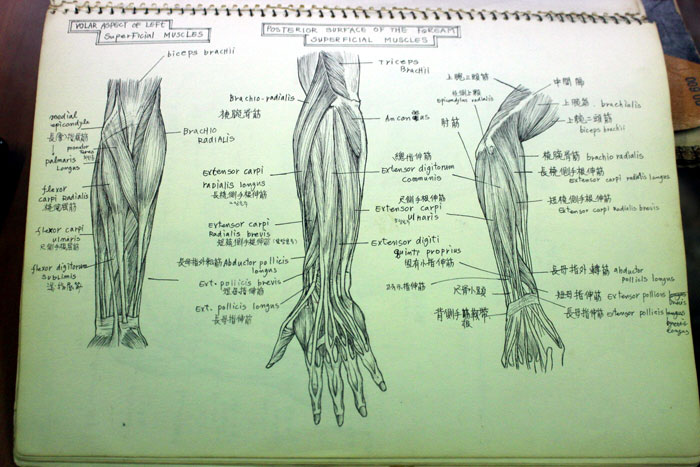
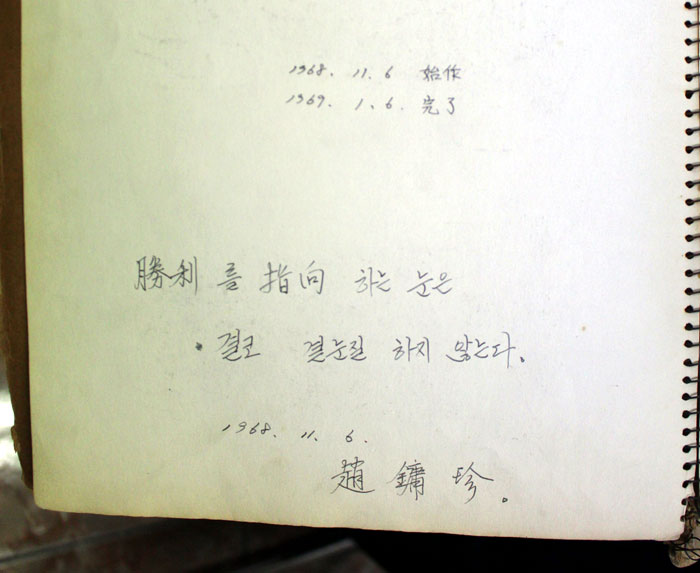
The top photo shows drawings Cho made when he was a freshman at university. The second photo shows his drawings of a human anatomical chart where he wrote his resolution that, “Eyes focused on victory never look to the side.” He began the drawings on November 6, 1968, and finished them on January 6, 1969.
- It may sound like a silly question, but why do you conduct research into the human face?
Faces are the expression of genes. Gene information is well-revealed in the face. Many aspects will come to the fore when looking into someone's ethnic or family heritage. There are a very small number of genes that define one's facial appearance. There are approximately 20,000 genes that make up the human brain. On the Korean Peninsula, it was the southern race people who lived here first. The northern race people didn't move to the region until later. Our basic features are of such southerners. Quite simply, we arrived upon the faces of modern Koreans sometime during the Unified Silla period (668-935). The racial homogenization of the country took place at that time. In the case of Japan, the faces of people from the East and the West show 120 times the number of differences, but, still, both of them show very strong homogeneity. The unification of Silla formed the original racial base for modern Koreans. Linguists also say the original form of our language is rooted in the language spoken by Unified Silla.
- Are there any different features remaining in Korean genes?
Yes, they are. These genes still exist. The 6,000-year-old human bone found on a small island near the beach at Tongyeong, in South Gyeongsang Province, reminds us that we are all African in origin. The back of the head was lifted high like that of Africans. The color of the skin is assumed to be darker, too.
- Do you expect a big change in the generic Korean face in the future?
People do not move much. It is not difficult to understand the features of the face. Today, for example, in South Chungcheong Province some 68 percent of couples find their partners in the same province. This is the lowest proportion for married couples who marry inside the province, compared to other areas. In regions like South Gyeongsang or South Jeolla, the proportion is around 85 percent. So there will be no big change in the local gene pool. Naturalized Koreans from Southeast Asia come to many regions, but most of them are women, which does not have much effect.
- Is there any concern that your method of categorization could lead to accusations of racism?
Simple people might think so. For Koreans, it seems, due to the lateralization of brain functions, the right side of the brain might cause them to jump to conclusions. So I am cautious, because they may be prejudiced. I mean there is such a pattern among Korean, though this doesn't apply to everyone.
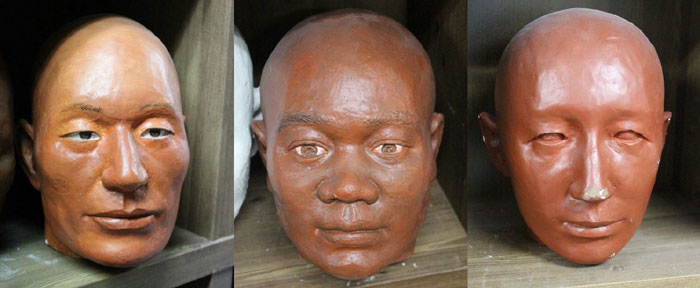
Cho recreated the facial appearance of people who used to live on the Korean Peninsula. The left face shows the person who was found in Hawngseong-ni in Jecheon, Chungcheongbuk-do. He is assumed to have left for Korea from Northern Europe about 2,300 years ago. The center face shows the face of a person who was found on Yeondaedo Island off the beach of Tongyeong. The shape of this person reminds us of a person with African origins. The right face is the future of the Korean face, which will probably be seen in the year 2100.
- So do you mean to say that there will be no major changes once the basic gene features are set?
To change the features, it will require an influx of people, about 12 percent of the total population at once. Such an influx would be impossible here. Imagine it. Would it be possible that 10 million people immigrate to Korea? Therefore, we can broadly predict the future. The Korean right brain will lateralize brain function in the future as well. They will be slightly taller than future Japanese people. Common diseases among Koreans, such as diabetes, tuberculosis and osteoporosis, will continue to exist. We will need to respond to the future with such consistency.
- Are linguistic habits related to brain activities?
The languages of Southeast Asia have many nasal sounds. It is good to have all phonemes without leaning too much on specific parts. In Mandarin, there are not many “[g]” sounds. Anatomical features are imbedded in linguistic pronunciation. If people do not use it, it will be degenerated. We also need to revive the sungyeongeum phonemes (순경음, 脣輕音) in the Korean language. They are a series of light sounds created from the lips in ancient Korean. It existed in the Korean language in the past. If we stop using it, we will stop using the related part of the brain because it is also related to behaving meticulously. The speech center of the brain is related to not only speaking a language. It is also related to a meticulous manner of thinking and acting. As a language is one cultural feature that affects the brain throughout the life time, we should conduct more research into this aspect of the Korean language. As Korean lacks many consonants, the use of the left brain is also relatively low.
- What is the ultimate goal of your research into the human face?
Based on my research, we need to supplement what we lack through education. For instance, as long and short sounds have both disappeared from the Korean language, we need to educate people about them as soon as possible. The weak use of the left brain leads to an absence of long and short sounds, which causes there to be more hard or aspirated consonants in the language. It makes the language sparse in vocabulary and reduces the number of expressions possible for comparative and superlative expressions. The right side of the brain has a thin cortex, which tends to be consumed easily. So it causes people to judge quickly and to act fast. However, they tend to be weak in making a strong finish of things. In Korean, many accents are stressed on the first syllable, while the remaining syllables are ignored. This will cause people to be slow in making use of the brain as a habit. We need to boost the use of our left brain to keep balance.
Article by Wi Tack-whan, Yoon Sojung
Photos by Wi Tack-whan
Korea.net Staff Writers
whan23@korea.kr
Most popular
- First hearing-impaired K-pop act hopes for 'barrier-free world'
- Expats could account for 7% of population in 20 years: report
- 'Mad Max' director impressed by 'cinema-literate' Korean viewers
- Show in Italy to present 'thought-filled' Korean craftworks
- Romanian presidential couple visits national cemetery




